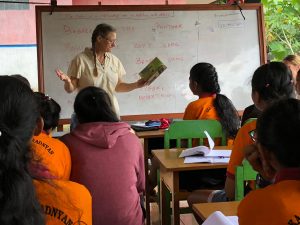
An engaging teacher keeping her students’ attention
The final days of our time teaching English in Samasaman Village were quite enjoyable. We had developed a wonderful rapport with Intan, the resident teacher and a notably curious and bright individual. Having hired dozens of teachers over the years, I know what to look for. And Intan, the lead teacher at Yayasan Eka Chita Pradnyan Learning Center, is someone I would certainly hire if I could. She has the qualities of being an earnest learner, a person eager to expand her capacities, and a person of the world. She is notably disinclined to accept a small definition of her work and instead seeks the broadest and most impactful role possible. Intan is a person destined, I believe, for greatness, however the interplay between the world around her and her ambitions define that term.
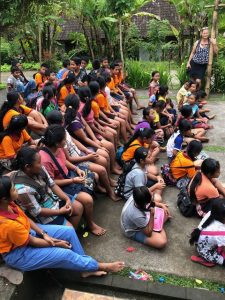
The student body at Samsaman Learning Center
In any case, we got a lot out of teaching at the Learning Center. The kids were for the most part extremely well behaved and sharply curious. We made very fun personal connections with many of them, though two weeks (at just a few hours per week) is not enough to move beyond initial bonding. Of course being kids, they were as a group quite playful and irreverent. This made our time there very pleasant, and made the kids’ parting comments about their eagerness for our return plausible.

Ketut & Made, Learning Center founders
We also benefited greatly from Ibu Ketut Sunarmi and her husband, Made, who proved to be excellent hosts. I’d been a bit wary about living on-site, knowing how education jobs can become your entire life, but Ketut and Made were entirely gracious and accommodating throughout.
Our final class was probably our best. I contributed a lot to the class design, but Lisa took the lead role. She’s a natural teacher, and her leadership often characterizes our best teamwork. We worked with the older group on social skill development, in concert with February’s theme of Family and Friends. This class involved, first, a reading of the story Jungle Book (the preschool edition, which from a language acquisition perspective was at a perfect level for the 11-to-14 year old group.) Lisa read the story with vibrant voice tones and facial expressions, dramatizing the tale of Mowgli and his animal companions with enthusiasm and evident impact. We then asked the kids to think about the kind of relational qualities that linked the characters in the story – friendship, respect, fear, admiration, companionship, mentorship, etc.
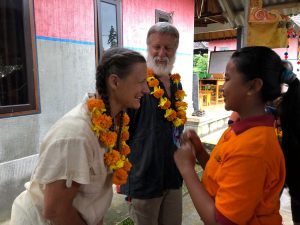
Lisa is presented with symbols of honor
As a transition, we had kids formulate appreciation statements for each other, using the relational qualities they had identified. In the closing exercise, they took part in an appreciation circle in which they expressed – in English, of course – appreciation for each other based upon qualities that they experienced in their relationships. This was both a way for us to introduce the use of appreciation circles (which we have widely taught over the years) while also serving the monthly theme.
The kids seemed to get a lot out of it. The class involved careful listening, reflection, identifying qualities of relationships, writing statements of appreciation, and then speaking with each other – a robust range of learning activities.
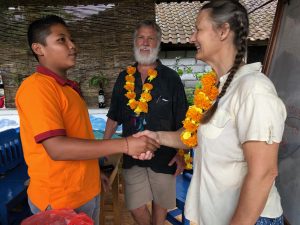
Bidding farewell to Delon, one of our favorite kids
At the end of this final class, despite protestations that it was unnecessary, we were ourselves the objects of an appreciation ceremony. Ibu Ketut Sunarmi, along with Intan, honored our brief contributions with a gift, a song, flower necklaces, certificates of appreciation, and a sort of receiving line in which each kid came up and thanked us, unanimously begging us to return.
I’m pretty sure that most of the kids were sincere in this request. I do know that we don’t fit the mold of most volunteers at the Learning Center. Not being college students or young travelers, Lisa and I are demographically aligned with their parents. This gave us (skills notwithstanding) a certain stature among the kids. And combining that stature with our unusually playful and experiential approach to teaching made us a novelty, with influence outpacing our actual capacities.

The departing volunteers are both happy and sad
Leaving Yayasan Eka Chita Pradnyan Learning Center, we felt a measure of sadness and separation. But two things mitigated those feelings. One is the aforementioned maturity. For us, this was not a pivotal episode in our professional development in which unprecedented connections with kids helped shape our sense of self. Instead, we contributed in ways largely separate from issues of ego satisfaction. The other mitigation was our knowledge that it is not particularly farfetched to think of returning. We’re not embarking upon career paths that will limit traveling or doing further volunteer work. And we’ve built a connection to Bali that has captivated us, making us more likely than not to return.

A wise elder primate (wisdom is evident in the white whiskers)
From Samsaman Village we moved our base camp to the tourist hub of Ubud. This was a mixed blessing. On the one hand, we suddenly had a bevy of diverse experiences to explore, including many food and cultural options unavailable in Samsaman. On the other hand, we traded in the pastoral bliss and simplicity of village life – in an area devoid of tourists – for a noisy foreigner-dominated city. This led to uncomfortable paradoxes, such as being repulsed by pricey spas and crystal shops while also savoring the chance to eat fresh salads and pizza.

“Maaaa… just lemme go play!”
Our stay in Ubud was essentially a pursuit of understanding Balinese culture. We started at the Monkey Forest, a park dedicated to monkeys, ancient temples, and sculptures. It’s a tourist magnet that drew us, because how can one not enjoy watching the antics of uncaged and unfettered fellow primates? Particularly enjoyable moments: watching baby monkeys chasing and playing; seeing a monkey sitting in apparent interaction with its carved stone likeness, and watching proper young European women horrified by monkeys mating unabashedly less than a meter away from them.
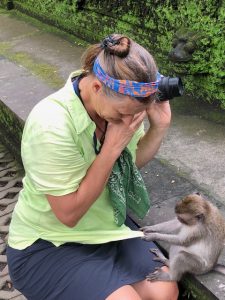
Not tame nor well behaved. Cute, though! The monkey was pretty cool, too.
One might wonder how visiting monkeys helps understand Balinese culture. This forest, where the monkeys are habituated to humans yet uncaged and untrained, reflects the tacit acceptance of nature characteristic of Bali. And the forest is explicitly dedicated to Tri Hita Karana, or “Three paths to spiritual and physical well-being.” These include harmonious relationships between humans and humans, humans and their environment, and humans and the “Supreme God.” I’d be hard pressed to describe the “Supreme God,” but I can say that being amidst 600 free ranging monkeys, a few dozen hectares of mature jungle, and temples over 500 years old, fostered a strong sense of harmoniousness.
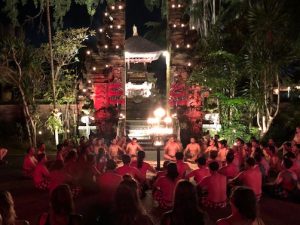
Firelight and chanting enrich storytelling! Click below to hear the mystical sound.
Another rich experience was attending a fascinating Kecak dance performance. This traditional art form involves a dramatic reenactment of the Ramayana accompanied by a chorus of maybe 60 half naked men. They performed a sort of crazy, rhythmic, a capella singing/chanting that was nothings short of magical. It is hard to describe but amazing to hear, and all done by firelight. Since Lisa and I are reading the Ramayana to each other on our travels, this was a great chance to see avatars of Rama, Sita, Lakshmana, Hanuman and other characters of the classic Hindu epic in full costume dancing out their story.
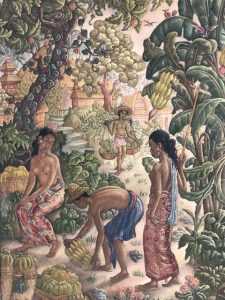
Pastoral Balinese imagery at Neka
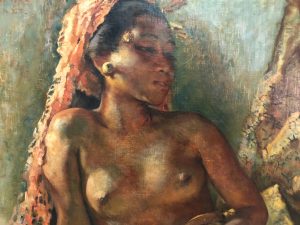
Beauty in abundance at Neka Museum
The Neka Art Museum was also a rich part of our cultural tour. The place was clean, quiet, and very well laid out. Of particular interest were historical and legendary artworks depicting Balinese tribal life – surprisingly not too different from village life of today – and depictions of, once again, the Ramayana, along with other stories from the Mahabharata. The Neka’s collection includes numerous sculptures and more contemporary art as well. I was pleased to find a bamboo gamelan in one gallery set up for visitors to play. Although I have no skill with this instrument, I was able to roughly mimic some of the rich music we’ve heard in Bali, and to hear it resonate through the quiet museum.
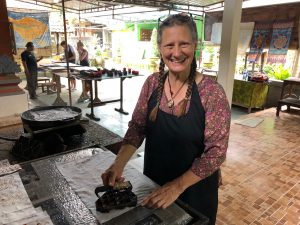
Lisa in her happy place
Perhaps the culmination of our dive into Indonesian arts and culture was a daylong batik workshop. We were assigned a teacher named Komang, who very patiently and competently guided us through the process of creating our own batik artworks. What a cool process! Essentially it involves tracing a pattern onto fabric, outlining the pattern with a thin bead of hot beeswax applied with a canting tool, (pronounced “chanting”) then painting in the many wax-defined cells with colored dye. Finally, after the dye dried, we ran the fabric through a mordant to set the color and a hot bath to remove the wax. Both Lisa and I chose to make mandala patterns, though others in the class made floral designs and Ganesh figures.
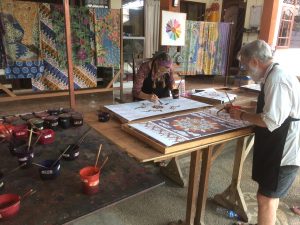
Everyone should have their creativity nurtured by experts!
The system of instruction at the batik school was very effective, and Komang was an excellent teacher. Our learning was enhanced by having a practice panel with a design similar to (but much simpler than) the design we had chosen, so that at each stage of the creation we had a chance to practice the new skill. We also got a lot of hands-on instruction by Komang, a very laid back but skilled batik artist. The results were astounding; both Lisa and I produced work that surprised us. We had a fun day of it, gained some cool skills, and couldn’t leave without Lisa picking up a kit containing all the tools, wax, dyes, etc. needed to pursue this craft at home!
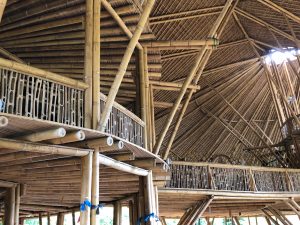
A school made entirely of bamboo
Combining professional interest with tourism, we made a side trip to a school outside Ubud called the Green School. I will write more about this impressive place in a future blog entry, but we much enjoyed our tour. The place is entirely built of bamboo, reflecting their commitment to ecological harmony. And yes, being on the campus of a progressive school evoked some comparisons with (and residual grief for) a certain school we once built. But it was great to see others pursuing their dreams and helping to pioneer student-centered and ecologically purposeful education.
Being in an explicitly educational environment drove home the fact that we are, for the rest of our journey, called to being learners, not teachers. So how to be the best learner possible? Bali is a good place for such lessons. The humility and openness of the people, the artistry that seems woven into daily life, and the widespread sense of human interconnectedness, all make this culture a rich one for cultivating a beginner’s mind. We are very much blessed to be alive in such a world as this.


Thank you Daniel, it is very nice what you wrote about me.
I regret to tell you that you made a few errors again. The boy’s name is Delon, not “Delan” as you wrote it on the photo caption, and the hot wax pipe for creating Batik patterns is called “Canting” not “Janting” 🙂
Wow, you also visited the bamboo school! I have seen that school on television and cannot wait to see it for real.
Thanks again, Intan, for your diligent reading and corrections of my text. I’ve made the changes you pointed out. As far as the “bamboo school.” I will write more about it in a future post.
daniel, thank you for this post. Its very inspiring.
Really when someone doesn’t understand afterward its up to other viewers that they will help, so here it takes place.